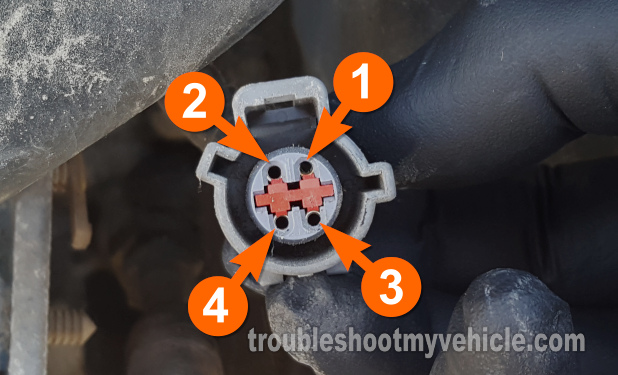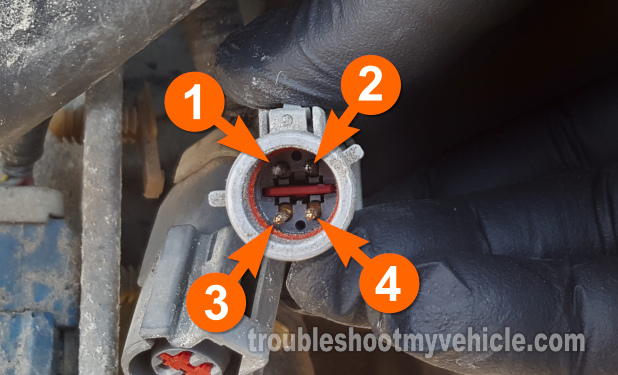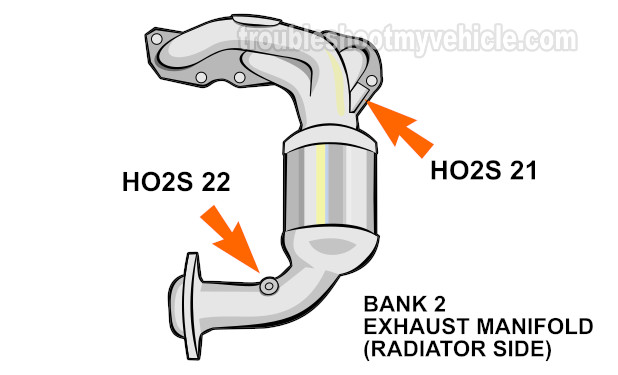
This tutorial will help you test the heater element in the HO2S-21 oxygen sensor on the 2001-2004 3.0 Ford Escape (3.0L Mazda Tribute).
Testing the heater element within the O2 sensor is not hard. Best of all, you don't need any expensive diagnostic equipment to do it. I'll show you how to do it with just a multimeter.
Also, you'll be able to easily diagnose a P0155 diagnostic trouble code with the help of this tutorial.
Contents of this tutorial:
- What Does Trouble Code P0155 Mean?
- Where To Buy The Oxygen Sensor And Save.
- Circuit Descriptions Of The HO2S-21 Oxygen Sensor.
- TEST 1: Making Sure The O2 Sensor's Heater Is Getting 12 Volts.
- TEST 2: Making Sure The O2 Sensor's Heater Is Getting Ground.
- TEST 3: Testing The Heater Element's Resistance.
- Location Of Oxygen Sensor HO2S-21.
- More 3.0L V6 Ford Escape Tutorials.
APPLIES TO: This P0155 diagnostic test tutorial applies to the following vehicles:
- 3.0L V6 Ford Escape: 2001, 2002, 2003, 2004.
- 3.0L Mazda Tribute: 2001, 2002, 2003, 2004.
HO2S 21 CIRCUIT WIRING DIAGRAM:
OTHER 02 HEATER DIAGNOSTIC TESTS:
- P0135 -O2 Sensor Bank 1 Sensor 1 Heater Tests (2001-2004 3.0L V6 Ford Escape).
- P0141 -O2 Sensor Bank 1 Sensor 2 Heater Tests (2001-2004 3.0L V6 Ford Escape).
- P0161 -O2 Sensor Bank 2 Sensor 2 Heater Tests (2001-2004 3.0L V6 Ford Escape).
What Does Trouble Code P0155 Mean?
A P0155: Heated Oxygen Sensor Heater Circuit Malfunction (Bank 2 Sensor 1) trouble code means that there's a problem with the internal heater of the front oxygen sensor for bank 2.
Quite a few things can cause a P0155 trouble code to light up the check engine light on your 3.0L V6 Ford Escape (3.0L Mazda Tribute), it usually boils down to one of the following:
- The HO2S-21 oxygen sensor's heater has failed.
- The O2 sensor's heater is not getting 12 Volts because its power wire has an open-circuit problem.
- The O2 sensor's heater is not getting Ground because its Ground wire has an open-circuit problem.
- The wires that supply 12 Volts and Ground to the O2 sensor's heater have shorted together.
The HO2S-21 oxygen sensor is located on the exhaust manifold that faces your Ford Escape's radiator. You can see it's location on the exhaust manifold here: Location Of Oxygen Sensor HO2S-21.
Where To Buy The Oxygen Sensor And Save
The HO2S-21 oxygen sensor is known by a lot of names and this can cause a lot of confusion when it's time to purchase a new one. To help you out, here's the original equipment Motorcraft part number: Motorcraft DY878.
The following links will help you to comparison shop and save a few bucks on the HO2S-21 oxygen sensor:
Disclosure: As an Amazon Associate, I earn from qualifying purchases. If my tutorials help you, using these links is an easy way to support the site at no extra cost to you. Thank you!
NOTE: If you're not sure if the above upstream O2 sensor fits your particular Ford Escape (Mazda Tribute), don't worry, I researched the part numbers for you and the above O2 sensor's are the replacements for the HO2S-21 oxygen sensor on the 3.0L V6 Ford Escape and 3.0L Mazda Tribute.
Circuit Descriptions Of The HO2S-21 Oxygen Sensor
As you're probably already aware, the HO2S-21 oxygen sensor has 4 wires sticking out of its connector.
Two of those four wires feed the heater element (within the O2 sensor) with 12 Volts and Ground. It's with these 12 Volts and Ground that the heater element activates within the O2 sensor.
The heater element needs 12 Volts and Ground to activate and start heating the O2 sensor it's a part of
The table below has a brief description of the four wires that connect to the HO2S-21 oxygen sensor.
Here's a brief description of the four wires of the oxygen sensor HO2S-21 connector:
| O2 Sensor Bank 2 Sensor 1 (2001-2004 3.0L V6 Ford Escape And Mazda Tribute) | ||
|---|---|---|
| Pin | Wire Color | Description |
| 1 | LT BLU/ORG | Heater 12 Volts |
| 2 | YEL/LT BLU | Heater Ground |
| 3 | ORG | O2 Signal Ground |
| 4 | RED/BLK | O2 Signal |
NOTE: The HO2S-21 oxygen sensor's engine wiring harness connector has female terminals (see photo 1 of 2 above). The connector on the oxygen sensor itself has male spade terminals (see photo 2 of 2).
In case you're wondering why the oxygen sensor needs an internal heater, it's because to activate, it needs to reach and maintain a constant temperature of 600° Fahrenheit.
Even though the exhaust gas gets very hot, it isn't able to maintain the O2 sensor at a constant 600° Fahrenheit.
This is the reason why the O2 sensor needs and internal heater to help it reach and maintain a constant 600° Fahrenheit temperature.
TEST 1: Making Sure The O2 Sensor's Heater Is Getting 12 Volts

The very first thing that we're going to do, to start our O2 sensor heater element diagnostic, is to make sure that the light blue with orange stripe (LT BLU/ORG) is feeding the heater element with 10 to 12 Volts DC.
The light blue with orange stripe (LT BLU/ORG) wire connects to the terminal labeled with the number 1 in the image above.
The LT BLU/ORG wire gets these 12 Volts from fuse #5 of the Battery Junction Box. (underhood fuse/relay box).
If 10 to 12 Volts DC are present in the LT BLU/ORG wire, then our next step is to make sure that the YEL/LT BLU wire is providing Ground to the heater element.
If 10 to 12 Volts are not present in the LT BLU/ORG wire, then the next step is to make sure that fuse #5 (of the Battery Junction Box) isn't blown.
CAUTION: The oxygen sensor gets and stays very hot even after the engine is off! Perform this test with a completely cold engine. Be careful and take all necessary safety precautions! If you raise your vehicle with a jack, place it on jack stands!
IMPORTANT: To check the presence of 12 Volts, you'll test the oxygen sensor's engine wiring harness connector. This connector has female terminals as shown in the image above.
OK, this is what you'll need to do:
- 1
Locate the HO2S-21 oxygen sensor and disconnect it from its engine wiring harness connector.
- 2
Set your multimeter to Volts DC mode.
- 3
Turn the key ON but don't crank or start the engine (this will power up the O2 sensor's engine wiring harness connector).
- 4
Probe the light blue with orange stripe (LT BLU/ORG) wire of O2 sensor's connector with your multimeter's red test lead
The LT BLU/ORG wire connects to the female terminal labeled with the number 1 (see photo above). - 5
With the Key On Engine Off (KOEO), your multimeter should register 10 to 12 Volts DC.
Let's examine your test results:
CASE 1: 10 to 12 Volts are present in the LT BLU/ORG wire. This is the correct and expected test result.
This test result lets you know that the HO2S-21 oxygen sensor's heater element is getting 12 Volts from fuse #5 of the Battery Junction Box (underhood fuse/relay box).
Now we're gonna' make sure that the O2 sensor's heater element is getting Ground. For this test go to: TEST 2: Making Sure The O2 Sensor's Heater Is Getting Ground.
CASE 2: 10 to 12 Volts DC are not present in the LT BLU/ORG wire. This test result usually means that fuse #5, of the Battery Junction Box, is blown.
Your next step is to check the fuse and make sure that it's not blown. If it is blown, replace it and repeat the test.
If fuse #5 is blown, the most likely cause of this problem is that:
- The O2 sensor's wires are touching the exhaust pipe and the insulation of the LT BLU/ORG wire has melted, causing it to short to Ground on the exhaust pipe.
- The O2 sensor's wires are rubbing against a hard metal edge and the insulation of the LT BLU/ORG wire has been rubbed off, causing it to short to Ground.
Repair any visible heat damage to the wires and after replacing the fuse, repeat the test.
TEST 2: Making Sure The O2 Sensor's Heater Is Getting Ground

If you've reached this point, you've made sure that the LT BLU/ORG wire is feeding 10 to 12 Volts to the HO2S-21 sensor's heater.
Our next step is to make sure that the O2 sensor's heater is getting Ground. We'll do this with a simple multimeter voltage test.
The wire that provides this Ground, to the heater element, is the red with white stripe (YEL/LT BLU) wire. In the image above, the terminal labeled with the number 2 is the one that connects to the YEL/LT BLU wire.
If Ground is present, then we'll move on to the last test, which is testing the resistance of the heater element within the O2 sensor.
NOTE: To check the presence of Ground, you'll test the oxygen sensor's engine wiring harness connector. This connector has female terminals as shown in the image above.
IMPORTANT: Ground is provided by the fuel injection computer of your Ford Escape (Mazda Tribute). So, be careful and don't short the Ground wire to battery power or you'll fry the fuel injection computer. The multimeter voltage test I'm suggesting below is a safe way of testing for the presence of Ground in this wire.
OK, this is what you'll need to do:
- 1
Disconnect the HO2S-21 sensor from its engine wiring harness connector.
- 2
Set your multimeter to Volts DC mode and turn the key ON but don't crank or start the engine.
- 3
Probe the red with white stripe (YEL/LT BLU) wire of O2 sensor's connector with the black multimeter test lead.
The YEL/LT BLU wire connects to the female terminal labeled with the number 2 (see photo above). - 4
Connect the red multimeter test lead to the battery positive (+) post.
- 5
With the Key On Engine Off (KOEO), your multimeter should register 10 to 12 Volts DC.
Let's take a look at your test results:
CASE 1: Your multimeter registered 10 to 12 Volts DC. This is the correct test result and it confirms that the HO2S-21 sensor's heater element is getting Ground.
The next step is to verify that the heater's resistance is within specification. For this test, go to: TEST 3: Testing The Heater Element's Resistance.
CASE 2: Your multimeter DID NOT register 10 to 12 Volts DC. This test result tells you that the HO2S-21 sensor's heater element is not getting Ground.
The most likely cause of this missing Ground is an open-circuit problem in the Ground wire between the O2 sensor's connector and the fuel injection computer.
TEST 3: Testing The Heater Element's Resistance

For our last test, we're going to test the resistance of the heater element itself. This is a very simple test since it simply involves measuring the resistance of the heater element with a multimeter in Ohms mode.
The resistance specification of the heater element is 3 to 30 Ohms at room temperature.
If the resistance is not within the specification, then you can conclude that the O2 sensor is bad and needs to be replaced.
OK, this is what you need to do:
- 1
Locate the female terminals labeled with the number 1 and number 2 of the O2 sensor connector itself (not the engine wiring harness O2 connector).
NOTE: This connector has male terminals and belongs to the O2 sensor itself. - 2
Place your multimeter in Ohms mode.
- 3
With your multimeter in Ohms mode probe terminals number 1 and number 2 of the O2 sensor's connector.
- 4
If all is OK, you should see about 3 to 30 Ohms (Ω) on your multimeter.
If the heater element is fried, your multimeter will show an open (usually indicated by the letters OL) or a number over 10 K Ω.
Let's take a look at your test results:
CASE 1: The oxygen sensor's heater resistance is within specification. This is the correct test result and tells you the oxygen sensor's heater element is OK.
CASE 2: The oxygen sensor's heater resistance IS NOT within specification. This confirms that the HO2S-21 sensor's heater element is fried.
You can conclude that the HO2S-21 sensor is bad and the cause of the P0155 trouble code if you have:
- Confirmed that the HO2S-21 sensor's heater element is getting 10 to 12 Volts (TEST 1).
- Confirmed that the HO2S-21 sensor's heater element is getting Ground (TEST 2).
- In this test you have confirmed that the heater element's resistance is not within the indicated specification.
Taking all of the above into account you can correctly conclude that the HO2S-21 sensor needs to be replaced with a new one.
Location Of Oxygen Sensor HO2S-21

The Bank 2 Sensor 1 oxygen sensor (HO2S-21) is located on the exhaust manifold facing the radiator.
The illustration above is of the exhaust manifold that connects to bank 2 of the engine (bank 2 is the bank for cylinders #2, #4, and #6).
More 3.0L V6 Ford Escape Tutorials
You can find a complete list of tutorials and wiring diagrams for the 3.0L V6 Ford Escape in this index:
Here's a small sample of the 3.0L V6 Ford Escape tutorials you'll find in the index:
- How To Test The Fuel Pump (2001-2004 3.0L V6 Ford Escape).
- How To Test The Fuel Injectors (2001-2004 3.0L V6 Ford Escape).
- How To Test Engine Compression (2001-2012 3.0L V6 Ford Escape).
- How To Test For A Blown Head Gasket (2001-2012 3.0L V6 Ford Escape).

If this info saved the day, buy me a beer!





